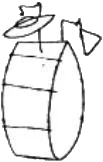Image file

We are recording in a month which has my brain in recording mode. My vibe for this next recording is to try to document the place we are recording at. If we are going to travel all the way to a studio in the mountains of Kyushuu to track songs, the listener better be able to receive some of that mountain-ness.
How do we make a record that sounds "mountain-y"? We have about 30 days to figure it out.